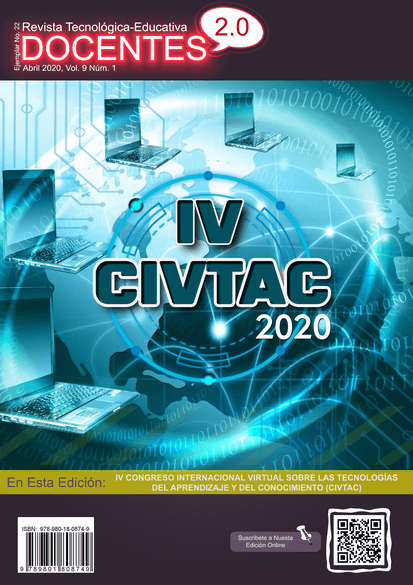The technologies of learning and communication (TAC) in the framework of teacher professionalization UNAE-Morona Santiago
 DOI:
https://doi.org/10.37843/rted.v9i1.93
DOI:
https://doi.org/10.37843/rted.v9i1.93
Main Article Content
Abstract
Learning and communication technologies (TAC) orient information and communication technologies (ICT) towards formative uses; reorienting the teaching - learning - evaluation process towards the learning subject (focused on the student), using a set of services, networks, applications and devices offered by the digital era aimed at improving the quality of learning processes. This study focuses on knowing how the use of technology allows to narrow the gaps in social inequalities by bringing knowledge and information closer to those who, due to social, economic and gender issues, have not completed their academic training at a higher level, under this context. The teacher professionalization of those who exercise the functions of teachers in the Province of Morona Santiago, both in the Hispanic and bilingual jurisdiction, have benefited from the distance courses offered by the National University of Education of Ecuador (UNAE), based on a pedagogical model Through the application of learning and communication technologies (TAC), it also promotes lifelong learning. Teachers interact with teachers through the Virtual Teaching and Learning Environment (EVEA), this platform is friendly and easy to use for those who fulfill the functions of teachers or students in this career. The result is centered on the experience obtained by relating the practice in face-to-face and virtual environments, as in the reflection of the importance of technology to erase borders of all kinds with the sole objective of generating new alternatives that help to educational excellence. The interaction between the TACs of the participating student-teachers generates motivation to move towards the professional development of teachers.
Downloads
Metrics
Article Details

This work is licensed under a Creative Commons Attribution-NonCommercial-NoDerivatives 4.0 International License.
Those authors who have publications in our journal accept the following terms:
- When a work is accepted for publication, the author retains rights of reproduction, distribution of his/her article for exploitation in all countries of the world in the format provided by our magazine and any other magnetic medium, optical, and digital.
- Authors will retain their copyright and guarantee the journal the right first to publish their work, which will be simultaneously subject to the Creative Commons Acknowledgment License (Attribution-NonCommercial-NoDerivatives 4.0 International (CC BY-NC-ND 4.0)). That allows third parties to copy and redistribute the material in any medium or format, under the following conditions: Acknowledgment - You must properly acknowledge authorship, provide a link to the license, and indicate if any changes have been made. You may do so in any reasonable way, but not in a way that suggests you have the licensor's endorsement or receive it for your use. NonCommercial - You may not use the material for a commercial purpose. NoDerivatives - If you remix, transform, or build from the material, you cannot broadcast the modified material. There are no additional restrictions - You cannot apply legal terms or technological measures that legally restrict you from doing what the license allows.
- Authors may adopt other non-exclusive license agreements to distribute the published version of the work (e.g., deposit it in an institutional archive or publish it in a monographic volume) provided that the initial publication in this journal is indicated.
- Authors are allowed and recommended to disseminate their work through the Internet (e.g., in institutional telematic archives, repositories, libraries, or their website), producing exciting exchanges and increasing the published work's citations.
- Request of withdrawal an article has to be done in writing by the author to the Editor, becoming effective after a written response from the Editor. For this purpose, the author or authors will send correspondence via e-mail: [email protected].
- The author will not receive financial compensation for the publication of his work.
- All Docentes 2.0 Journal publications are under the Open Journal System (OJS) platform at: https://ojs.docentes20.com/.
References
Aguilar, M. (2012). Aprendizaje y tecnologías de información y comunicación: obtenido de revista latinoamericana de ciencias sociales, niñez y juventud. https://dialnet.unirioja.es/servlet/articulo?codigo=4023457
Cabero, J. (1998). Impacto de las nuevas tecnologías de la información y la comunicación en las organizaciones. https://cmapspublic2.ihmc.us/rid=1mzf0mgpj-dw0c5j-nb1s/tics%20en%20educacion.pdf
Rodríguez-Ardura, I. & Gerard, R. (2001). Integración de materiales didácticos hipermedia en entornos virtuales de aprendizaje: retos y oportunidades. Revista iberoamericana de educación. https://www.researchgate.net/publication/28052510
Torres-Díaz, J., Jara, D., & Valdiviezo, P. (2015). Integración de redes sociales y entornos virtuales de aprendizaje. Revista de educación a distancia. https://revistas.um.es/red/article/view/233651
Universidad Nacional de Educación. (2017). Modelo pedagógico de la universidad nacional de educación UNAE. https://es.calameo.com/read/004628483229f19695c71
Zambrano, F. & Balladares, K. (2017). Sociedad del conocimiento y las TEPs. INNOVA Research Journal. 2(10).173-174. https://doi.org/10.33890/innova.v2.n10.2017.534






